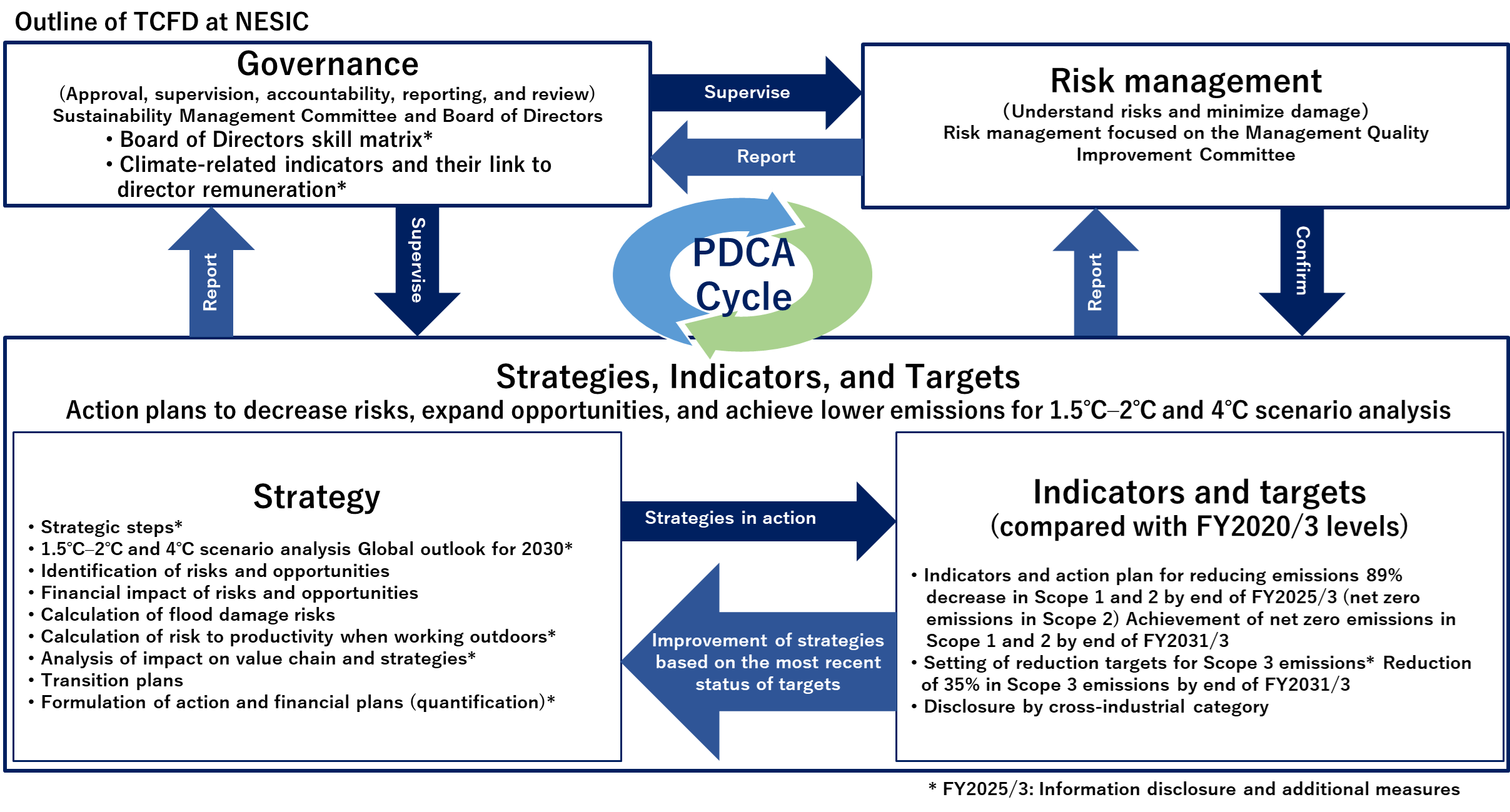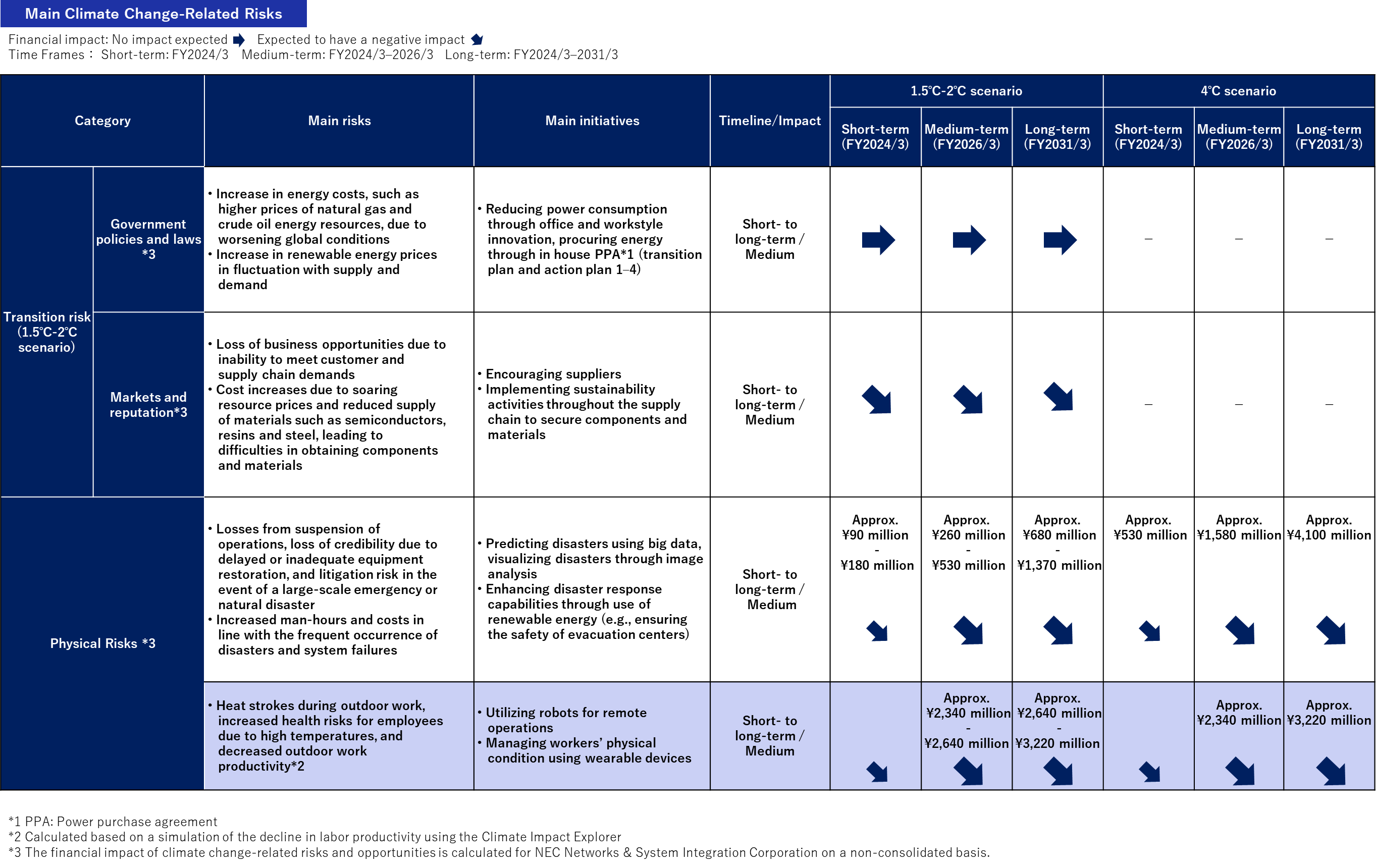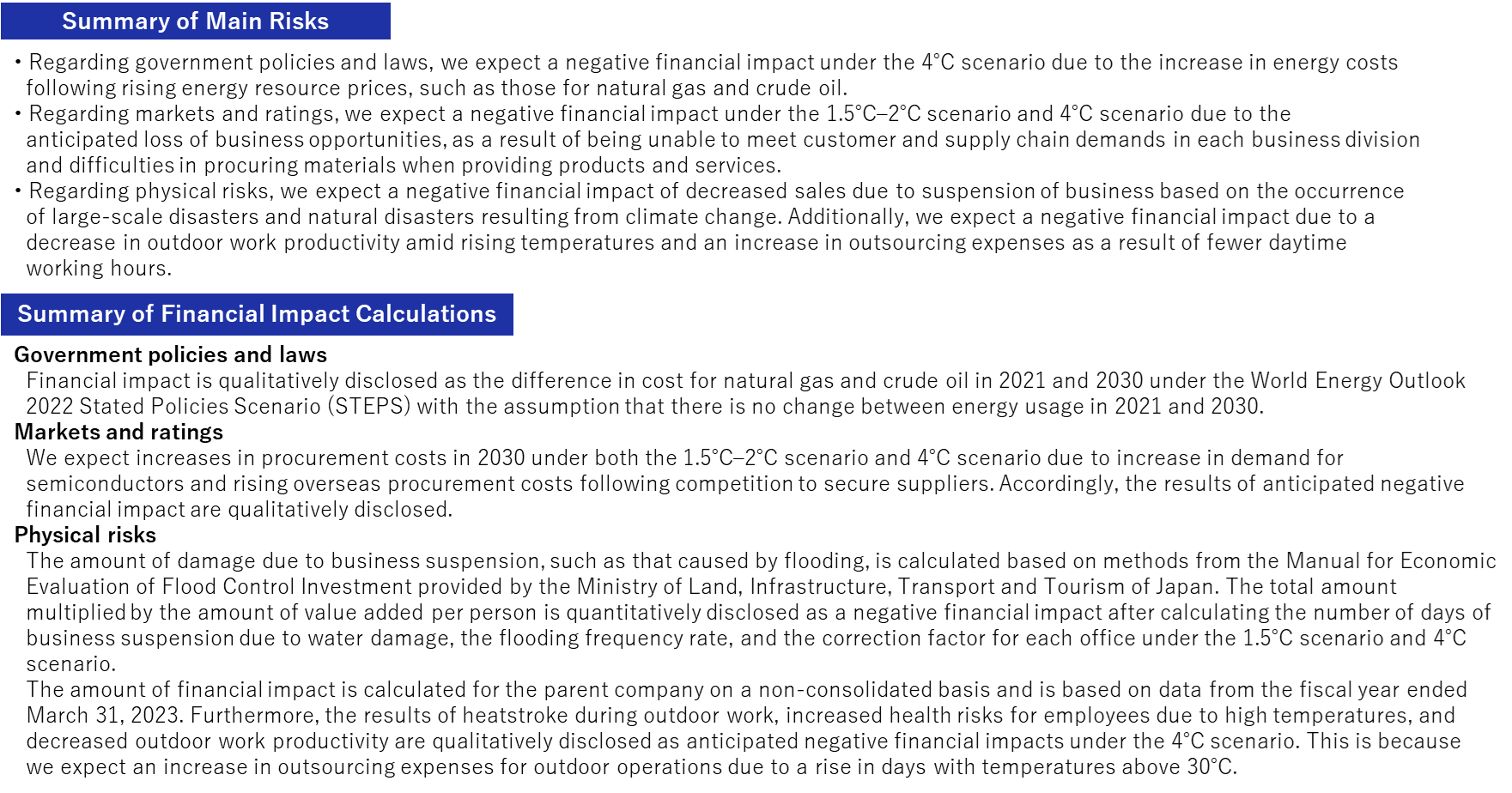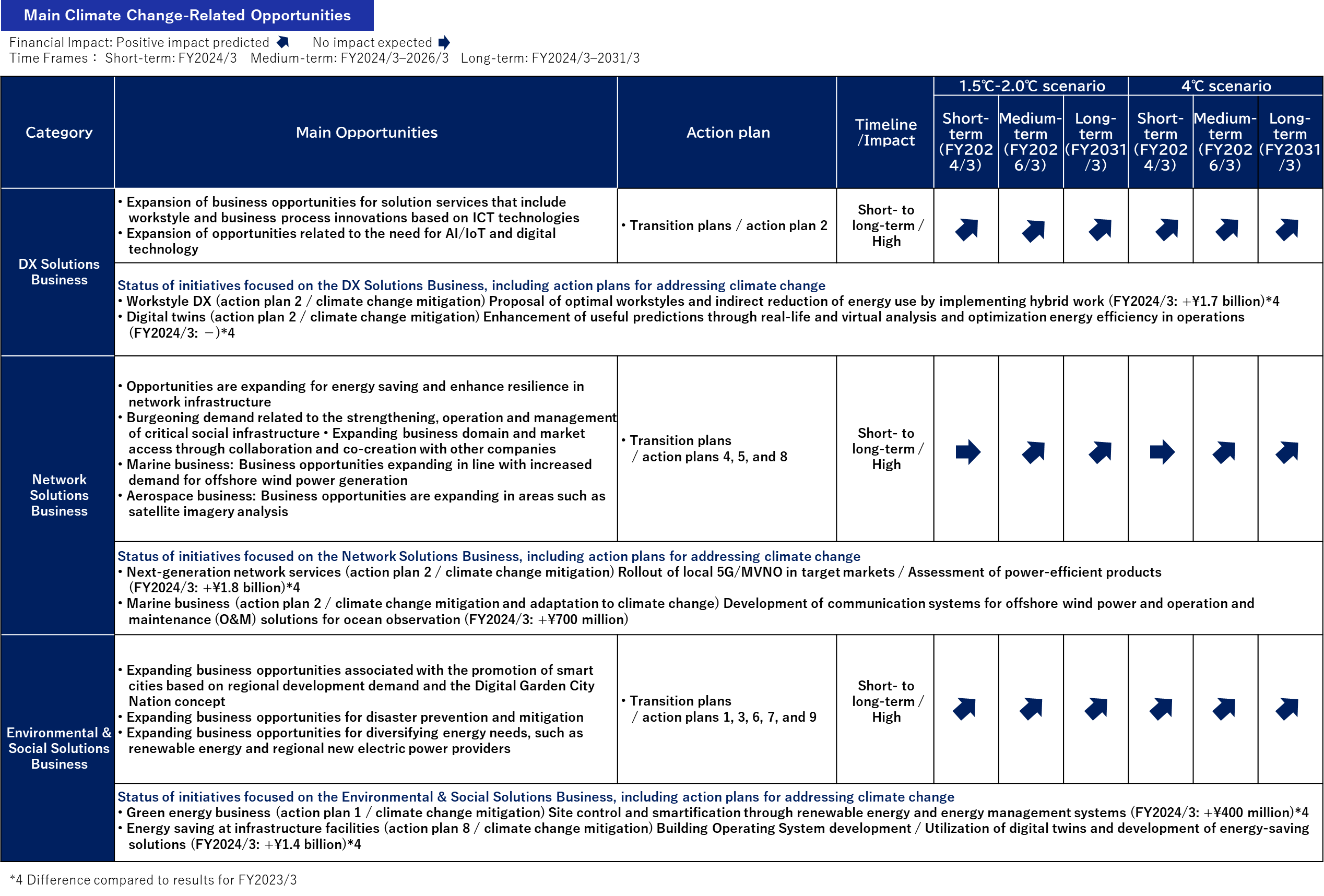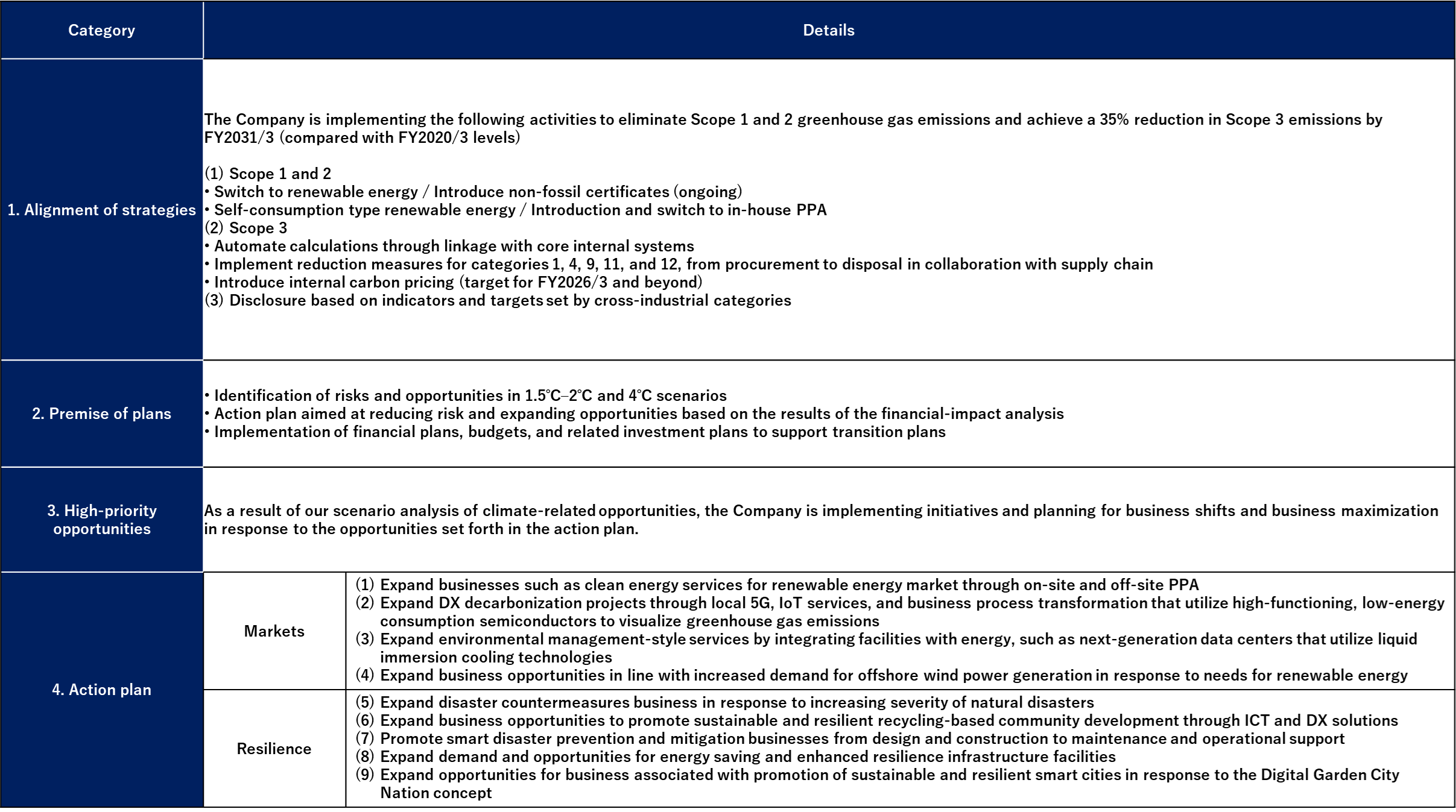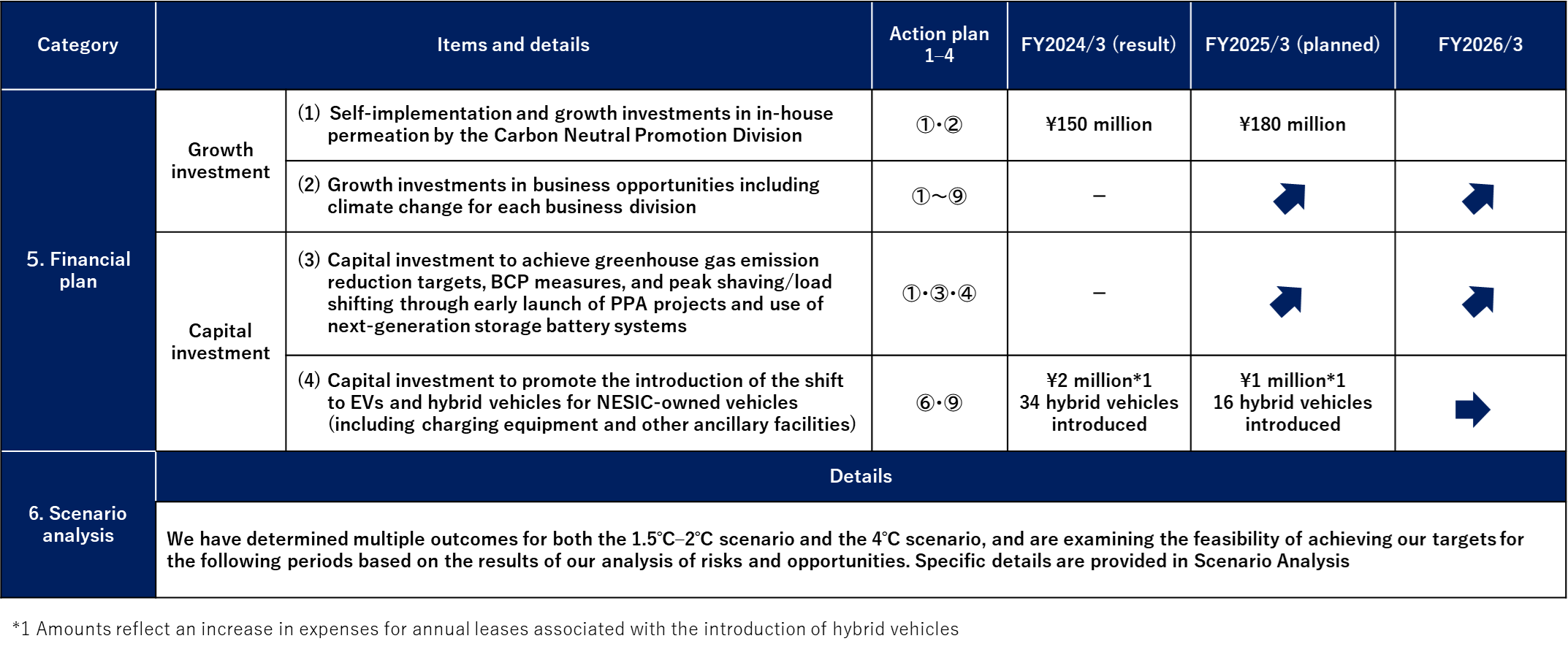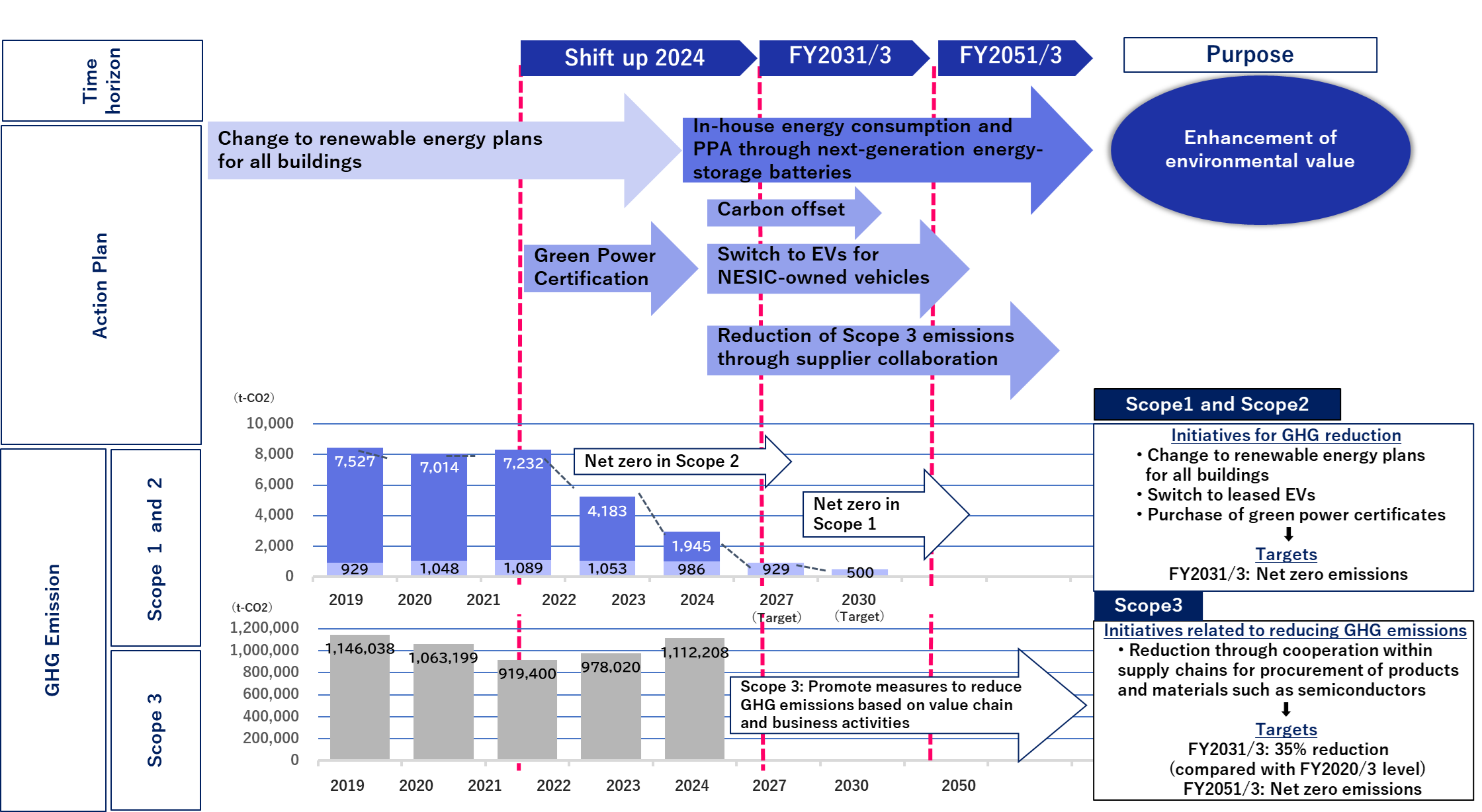Breadcrumb navigation
Environment
NEC Networks & System Integration Corporation1. Disclosures Based on TCFD Recommendations
Given the pressing need to establish sustainability management that includes measures to reduce greenhouse gas emissions and address the impacts climate change, such as global warming, NESIC recognizes the importance of climate-related financial information disclosure. Accordingly, the Company endorsed the Task Force on Climate-related Financial Disclosures (TCFD) in December 2021, and has since been disclosing information based on TCFD recommendations. We are working to disclose information in accordance with the IFRS S2 Climate-related Disclosures (IFRS S2) published in June 2023, and are engaged in activities to control risks related to climate change and create and seize opportunities.
Furthermore, as part of the NEC Group, we committed to formulating Science Based Targets (SBT) in December 2017, obtained SBT certification in 2018, and are promoting initiatives aimed at carbon neutrality with 1.5℃ certification from the SBT initiative for its current targets.
As greenhouse gas (GHG) emissions from the supply chain (Scope 3) are overwhelmingly greater than GHG emissions from NESIC (Scope 1, 2), we are pursuing reductions throughout the supply chain. We completed approximate calculations for the applicable Scope 3 categories for the fiscal year ended March 31, 2023 and received third-party verification in February 2023. We will continue to lower Scope 1 and 2 emissions, promoting thorough visualization and refinement of Scope 3 and promote emissions reductions throughout the supply chain.
Additionally, we will contribute to realizing a carbon neutral, sustainable society through ICT by participating in the GX League, a framework for driving green transformation (GX) led by the Ministry of Economy, Trade and Industry of Japan, and the Carbon to X (C2X) open innovation business platform while promoting the creation of climate change-responsive businesses.
From the fiscal year ending March 31, 2024, we are accelerating Groupwide business development by launching our Carbon Neutral Business Promotion Project.
2. Governance
Regarding issues critical to management strategy, the Sustainability Management Committee, which is a subcommittee under the Management Quality Improvement Committee and is chaired by the president and chief operating officer, examines strategies and measures and exchanges information pertaining to sustainability and ESG strategies, including climate change countermeasures, as well as risks and opportunities with the potential of significantly impacting our business.Sustainability Management Committee meetings are also attended by outside experts, including one outside director, who serve as advisors with a deep connection to sustainability. The results of deliberations are reported to the Board of Directors. In this way, a system is in place for the Board of Directors to oversee NESIC’s climate change measures to ensure that they are properly promoted.
The Central Environmental Management Committee, which handles themes within the Sustainability Management Committee, is chaired by the executive officer in charge of the environment. For matters deemed to have the potential to significantly impact medium- to long-term goals, such as vision, medium-term strategies, and major investments, a governance process has been established in which the Sustainability Management Committee discusses such matters and reports to the Board of Directors.
Furthermore, we are formulating targets for reducing CO2 emissions and promoting action through our business activities to achieve NEC Environmental Targets 2030 (NEC Group targets for environmental management), based on the Course of Action forClimate Change Toward 2050 as a member of the NEC Group.
In April 2022, NESIC established the Carbon Neutral Promotion Division, directly controlled by the president, to further strengthen and promote carbon neutral strategies and management. The Carbon Neutral Promotion Division is responsible for developing the company-wide framework for formulating carbon neutrality strategies, and establishing policies, milestones, and targets. It also collaborates with relevant divisions to sharpen the Company’s competitive edge, explore new business opportunities, co-create with customers and partners, and develop a green transformation (GX) strategy to achieve carbon neutrality.
Companywide Promotion and Governance Structure for Climate Change
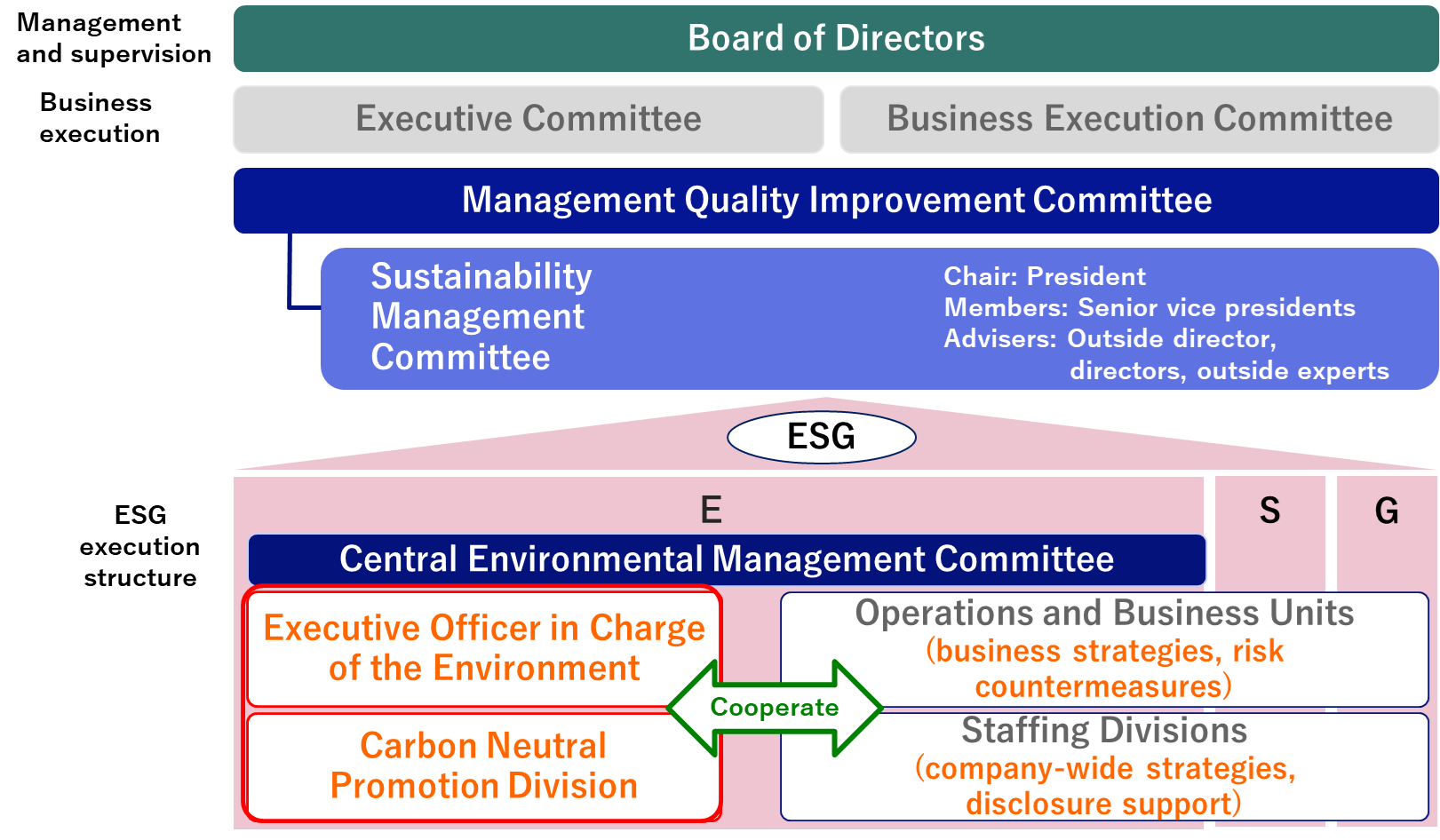
3. Strategy
Strategic Steps
Based on the 1.5℃–2℃ and 4℃ scenarios for climate change and taking into account IFRS S2, NESIC provides disclosures on the following matters.

Scenario Analysis
The Company recognizes that assessing the potential business impacts of risks and opportunities associated with climate change is and developing response measures is essential to achieving our vision of realizing an inclusive and sustainable society created through communication, as well as ensuring the sustainability of our operations.
To understand the impact of climate change on our business and identify climate-related risks and opportunities, we implemented the following analysis for various scenarios, referred to NEC Group assumptions regarding decarbonization scenarios in Japan while considering the global outlook for 2030, compared them with business environment assumptions in NESIC’s long-term strategies, and analyzed the differences.

We conduct scenario analyses through Companywide discussions in collaboration with the environmental, planning, and public relations departments, and business divisions.
In particular, discussions resulted in the prediction that bold measures and technology innovations will be promoted under the 1.5℃–2℃ scenario in the transition to a decarbonized society. Regarding transition risks, we analyzed that issues including the rising cost of energy, increasing raw material prices, and difficulties in procuring materials would become apparent. Under the 4℃ scenario, basic risks and opportunities would be the same but physical risks, such as the occurrence and increased severity of heavy rains and flooding, recovery measures for customer facilities, and increasing frequency of damage, will be relatively higher. Meanwhile, we recognize increasing needs across society for GHG emission reductions and renewable energy in its move toward decarbonization as an opportunity for NESIC to provide various ICT services that contribute to carbon neutrality.
We are reporting the results of carrying out analysis and evaluation regarding the details and amount of impact for each risk, our response to risks, and subsequent opportunities for growth as follows.
Time Frame in Which Risks and Opportunities Are Expected to Materialize
As the risks and opportunities associated with climate change have the potential to affect our business activities over a long period from the fiscal year in which they arise, we believe it is important to consider milestones in the short, medium, and long term, when we expect the risks and opportunities to materialize. We identify and respond to risks and opportunities by examining transition risks such as the introduction of government policies and laws and changes in market needs, physical risks such as abnormal weather caused by climate change, and increased opportunities in each business unit, and then reflect these risks and opportunities in our strategies.

Impact of Risks and Opportunities on Our Value Chain
We believe that the risks and opportunities associated with climate change have the potential to significantly impact our value
chain in the following ways.
■Definition and Composition of NESIC’s Value Chain
For the entire value chain, from procurement of raw materials to manufacturing, distribution, sales, maintenance, and the provision of solutions and services, we are reassessing each activity in terms of how it contributes to the creation of added value, and what the Company’s strengths and weaknesses are in relation to its competitors, in order to clarify the risks and opportunities associated with climate change for each element of the value chain, and to use this information to revise our business strategy.


Main Climate Change-Related Risks and Opportunities
■Overview of Main Risks and Opportunities
NESIC has compiled main climate change risks and opportunities in the operation of its three business segments based on multiple scenario analyses, collected future forecasting data for each risk and opportunity, and calculated the financial impact of risks and opportunities based on the definition of the time frames in which important risks and opportunities are expected to materialize.
Transition Plans

To address the issue of climate change, we are steadily taking steps to formulate strategies, reduce greenhouse gas (GHG) emissions, and aid in the shift to a low-carbon economy, based on the transition plan categories below. The financial plans, budgets, and related investment plan targets and scenario analyses that support the transition plans are as follows.
4. Risk Management
In addition to natural disaster risks such as heavy rain and flooding, the scope of threats that companies must consider is expanding, such as the Russia–Ukraine conflict.
NESIC stays informed of diversifying risks in a rapidly changing business environment and manages risks from the perspectives of both minimizing damage and ensuring business continuity.
Critical risks, including those posed by climate change, are identified and managed through a risk management system led by the Management Quality Improvement Committee. Additionally, the Sustainability Management Committee, which discusses management strategies and policies for measures based on those strategies, implements measures through deliberations, and in accordance with the Corporate Governance Code, reports to the Board of Directors while providing ongoing disclosure to stakeholders outside NESIC.
5. Indicators and Targets
As a member of the NEC Group, we set major KPI targets for reducing greenhouse gas emissions in the fiscal year ended March 31, 2023 in line with NEC Environmental Targets 2030 (NEC Group targets for environmental management). However, we have brought forward our targets for reducing Scope 1 and 2 CO2 emissions to accelerate our contribution to responding to climate change, which is our corporate responsibility.
For Scope 3, we refined data on CO2 emissions by engaging with the supply chain and in the fiscal year ended March 31, 2024 set targets for reducing emissions in line with the levels outlined by the Science Based Targets initiative. The Company plans to disclose revised emission reduction targets for 2030 and 2050 in the fiscal year ending March 31, 2028, with a view to achieving its target of achieving net zero GHG emissions by 2050.
<Major KPI Targets and Status of Achievement>

